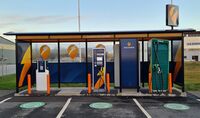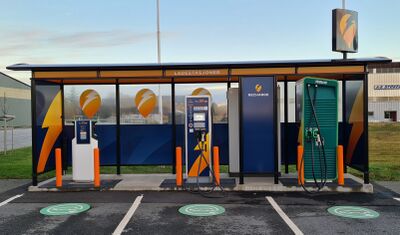Tag:amenity=charging_station
 |
| Description |
|---|
| A location where battery electric vehicles can be charged. |
| Rendering in OSM Carto |
| Group: amenities |
| Used on these elements |
| Implies |
| Useful combination |
|
| See also |
| Status: approved |
| Tools for this tag |
|
An EV charging station is a place designated for the use by EVs, such as electric motorcars, trucks and bicycles, for the charging of their battery. The equivalent in ICE vehicles is amenity=fuel. A charging station can be made up of one or more man_made=charge_point elements, which can be mapped separately.
- See also Charging station on Wikipedia.
How to map

 area.
area.1. Create an ![]() area around the entire charging station, including parking spaces and charge points.
area around the entire charging station, including parking spaces and charge points.
2. Add the tag amenity=charging_station. It is also useful to add socket=* information and brand=* when relevant.
3. Optionally: Add a ![]() node on each charge point. Refer to the charge point wiki page for useful tags on these.
node on each charge point. Refer to the charge point wiki page for useful tags on these.
When a ![]() node is appropriate: If you are unsure of the area the charging station encompasses, or are adding stations via an import, adding a
node is appropriate: If you are unsure of the area the charging station encompasses, or are adding stations via an import, adding a ![]() at the perceived center point of the charging station is encouraged.
at the perceived center point of the charging station is encouraged.
When a ![]() relation is appropriate: If there are several closely related clusters of charge points (for example, the same brand but across a parking lot). This should not be done if the stations are distinct but share a close proximity (such as two brands in a since parking lot). Also do not create a relation to segment adjacent groups of different chargers (e.g. by model our output) - a relation is only required if they are dispersed across an area.
relation is appropriate: If there are several closely related clusters of charge points (for example, the same brand but across a parking lot). This should not be done if the stations are distinct but share a close proximity (such as two brands in a since parking lot). Also do not create a relation to segment adjacent groups of different chargers (e.g. by model our output) - a relation is only required if they are dispersed across an area.
Tags
| Key | Status | Type | Description |
|---|---|---|---|
| Required Tags | |||
amenity |
Required | Top tag necessary on all charging stations consisting of one or more charge points. | |
| Suggested Tags | |||
brandoperator |
Suggested | The verifiable brand displayed on the station or charge points. If no brand is present, or the brand and operator are different, operator may be used using the *:wikidata where possible.
| |
access |
Suggested | private - Only accessible for dedicated individuals or vehicles (such as a workplace charging station.)customers - Dedicated for use by customers of an establishment regardless of affiliation (such as a hotel or vehicle-exclusive stations.)yes - For public access stations (such as shopping plazas.)
| |
socket:typesocket:type:output |
Suggested | Integer | Connector Information: Refer to the connector that plugs into the BEV when tagging socket information.socket:type - The cumulative total of given connector type. Refer to the socket page for a list of socket types.socket:type:output - The output of the connector. Expressed in Note: Semi-colon separated values can be used if required. For example, use |
| Optional Tags | |||
socket:type:currentsocket:type:voltage
|
Optional | Integer | Additional connector information. Optional because this information is often harder to determine and many data consumers (e.g. apps and website) opt not to show it as they deem it to be less relevant to the users.socket:type:current - The amperage of the connector. Expressed in socket:type:voltage - The voltage of the connector. Expressed in |
feecharge |
Optional | yes or no. If fee=yes, add charge for the amount, using conditional statements if necessary.
| |
opening_hours |
Optional | The hours which the station is available for use, using the opening hours syntax. If none present, it can be safely implied opening_hours=24/7.
| |
maxstay=*
|
Optional | Multiple | Restrictions relating to parking:
|
vehicle |
Optional | Charging Stations imply motorcar=yes, if not please specify with motorcar=no and reference vehicle values for appropriate access.
| |
capacity
|
Optional | Integer | The total number of vehicles which can be charged at the same time. This may be limited by the charging equipment or the number of parking spaces which the cables can reach to. Pick the lower of the these.
Notes:
|
ref |
Optional | String | The reference number present on the charging station.ref subkeys are used to link OSM EV data with external databases or sources. Some common ones are:
|
Examples
-
amenity=charging_station
brand=Recharge
access=yes
capacity=3
motorcar=designated
socket:type2=2
socket:type2:output=22 kW
socket:type2_combo=2
socket:type2_combo:output=150 kW
socket:chademo=2
socket:chademo:output=63 kW -
amenity=charging_station
brand=Tesla
capacity=8
motorcar=designated
socket:nacs=8
socket:nacs:output=150 kW
opening_hours=24/7
fee=yes -
amenity=charging_station
capacity=4
bicycle=designated
motorcar=no
Examples of bicycle charging stations
| Image | Tags | Notes |
|---|---|---|
|
Example of a small public e-bike charging station | |
|
Example of a large public e-bike charging station with multiple power outlets/cords. Add a separate node for | |
|
Example of a public e-bike battery charging locker. Key, Deposit coin, PIN code, and RFID card are all common lock mechanisms. |
Proposals
- Proposal:Charging station (2010) - Initial proposal with opinion poll and result: full endorsement.
- Proposal:EV Charging Station Mapping (2023) - Proposal for further clarification and voting: Status approved.
- Proposal:Charging place - Proposal for if there are many charging stations at one single place, they can be combined into a single charging place using a charging place relation.
Possible Resources
| Name | Region | License Compatibility | Description |
|---|---|---|---|
| PlugShare | no | PlugShare is a database of EV charging stations that combines user-reported stations, reviews, and elements with brand-provided information via the OCPI and commercial agreements. | |
| LEMNET | no | LEMNET is an older European EV charging map that had the ability to integrate with TomTom GPS devices. | |
| Ladestasjoner | maybe Needs Verification. |
Ladestasjoner is a primarily Norwegian site that lists charging stations throughout the many nordic nations. | |
| GoingElectric | no NonCommercial-ShareAlike 4.0 |
GoingElectric is a forum and charging map focused primarily on EV charge points within Germany. | |
| OpenChargeMap OpenChargeMap wiki page |
maybe See their wiki for discussion. Discussion needed. |
OpenChargeMap (ref:ocm in OSM) is a user-generated map of charging points that has both moderators and an automated approval process for station additions and updates.
| |
| Supercharge.info | yes | Supercharge.info is a community of Tesla-focused contributors that update data of Tesla Superchargers based on surveys, forum posts, and first-party updates.ref:supercharge_info is used to link these sites to the OSM database.
| |
| Ladestationen | yes | The Ladestationen map uses a OSM-based Leaflet map to display charge point data from the German Bundesnetzagentur. | |
| GRID (Formerly Oplaadpunten) |
no | Contains information from worldwide partners but primarily is focused in the Netherlands. | |
| Fietsoplaadpunten | no | Contains details such as opening hours, reviews, photos, and more exclusively covering The Netherlands. | |
| U.S. Department of Energy Alternative Fuel Data Center |
yes | Realtime updated database using OCPI, data partners, and US federal government surveyors of charging station and charge points in the United States and Canada.ref:afdc is used to link these sites to the OSM database.
| |
| E-Control Ladestellen |
CC-BY-4.0 with Additional rights for usage within OSM [1] |
Realtime Database including Socket types and Operators. |





